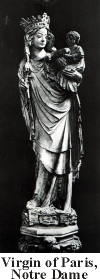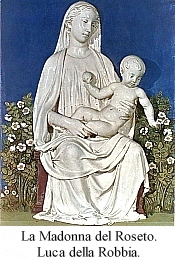The End of Europe's Middle Ages
This chapter is composed of four sections: Introduction, Architecture, Sculpture and Painting. Please follow the link at the end of each section to read the entire chapter.
Sculpture
The rise of Gothic architecture also led to the development of a new style of sculpture. Cleared of the dense crowding and frantic movement of the Romanesque style, Early Gothic sculpture reveals a new sense of order and symmetry, allowing figures to stand separate and apart from one another. Especially intriguing is the move to separate sculpture from its architectural setting. Although most sculpture continues to appear as an architectural component until after 1200, figures begin to be so deeply and individually carved that it seems they could be removed from their architectural supports with ease.
Accompanying the High Gothic architectural style of the mid- thirteenth century, sculpture also developed an increasing awareness of the contrast between light and shadow, utilising deep recesses and high ridges for emphasis. Strong S-curves, richly flowing draperies, curling hair and beards typified the conspicuous gracefulness of the 'elegant style' of High Gothic sculpture.

By the beginning of the fourteenth century, however, sculpture retreated from the graceful realism of the 'elegant style' and abstracted the human form into an attenuated tube. The S-curve and flowing draperies persisted but the body became curiously devoid of volume. This edited realism was balanced by an endearing attention to the detail of life. One of the best examples is in the early fourteenth century statue, "Virgin of Paris." Even though the bodies of Mary and Christ are extended and ethereal, the Infant Christ remains a baby, playing with his mother's veil.
Since few examples of Gothic sculpture survived the Reformation in England, it is difficult to determine whether a distinctive English style had developed. Nonetheless, the best remaining sources, tomb sculpture, display a unique vivacity and vigour that has no counterpart on the Continent.
After 1220, German masters trained in France and the influence of the French style is obvious even though German sculpture remained closely tied to its architectural setting. One of the best artists in German Gothic sculpture is the so-called Master of Naumburg whose best-known work are the mid-thirteenth-century carvings in the Naumburg Cathedral. The figures are heroic and dramatic, yet intensely human, each carved with a distinctive personality as exemplified by the sculptures of the noble couple, Ekkehard and Uta.
The search for solidity and reality climaxed in the late fourteenth century. One of the greatest artists in this new International Style was Claus Sluter, a Dutch sculptor working in Burgundy. Sluter's figures are enlarged both in size and in the boldness of their three-dimensional carving. Reminiscent of the 'elegant style' that had been abandoned a century before, the figures are realistically detailed and seem about to step away from their supporting backgrounds. Surprisingly, the realism of the International Style did not extend to the emotions, and the figures retain a sense of serene dignity independent of the vigour or violence of their actions.
As with architecture, Italian sculpture followed its own path. The earliest Gothic sculpture was probably produced in the mid- thirteenth century in southern Italy under the authority of the German Emperor Frederick II. Extensive use of classical styles suited the Emperor's claims as the heir to the Roman Empire, blending well with Italian interpretations of Romanesque architecture.
In the late thirteenth century, the works of Nicola Pisano (c.1225-before1284) and his son, Giovanni (1245/50-1314+), reveal the Italian preference for Classical influences. Both men carved pulpits at Pisa, permitting a comparison of styles. While both pulpits are evocative of Roman reliefs, Nicola's displays a tangle of thrusting masses while Giovanni's plays with the idea of space, relying on shadows and hollows for artistic impact.
Luca della Robbia (1400-1482) was the only other Italian sculptor of significance to immediately follow Donatello. His greatest works were marble reliefs that he imbued with a gentle gravity. Della Robbia never expanded into freestanding sculpture and his fame derives from his work in the less expensive medium of terracotta. Glazed in white, to imitate the appearance of marble, the figures stood out against the background of deep blue that characterised his work. Later Italian sculptors such as Bernardo Rossellino (1409-1464), Antonio del Pollaiuolo (c.1423-1498), Niccolò dell'Arca (c.1435-1494) and Andrea del Verrocchio (1435-1488) recombined detailed realism, dynamic movement, and emotional intensity in a style that would typify future developments in Renaissance sculpture.
The importance and influence of art in the Middle Ages can be seen in the development of new spiritual imagery. Prior to the end of the thirteenth century, Gothic sculpture was limited to attempts to imbue traditional Christian images with emotional appeal.
In the late 1200s, however, artists turned the tables, seeking out ways to express emotion through religious representations and a new kind of religious imagery for private devotion emerged. The Pietà, the figure of Mary grieving over the dead Christ, has no scriptural basis but serves as a tragic counterpoint to the traditional Madonna and Child motif. The Pietà became one of the most common expressions of pious grief throughout the later Medieval and Renaissance periods.
 |

